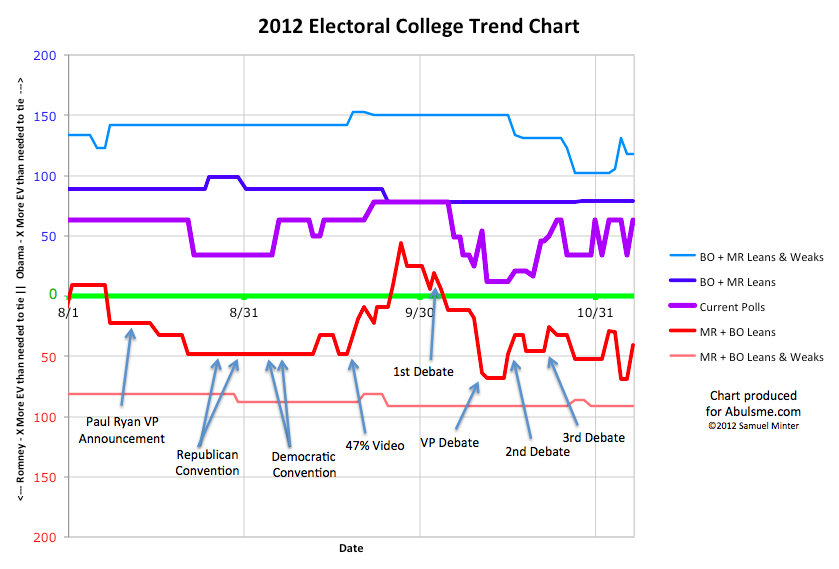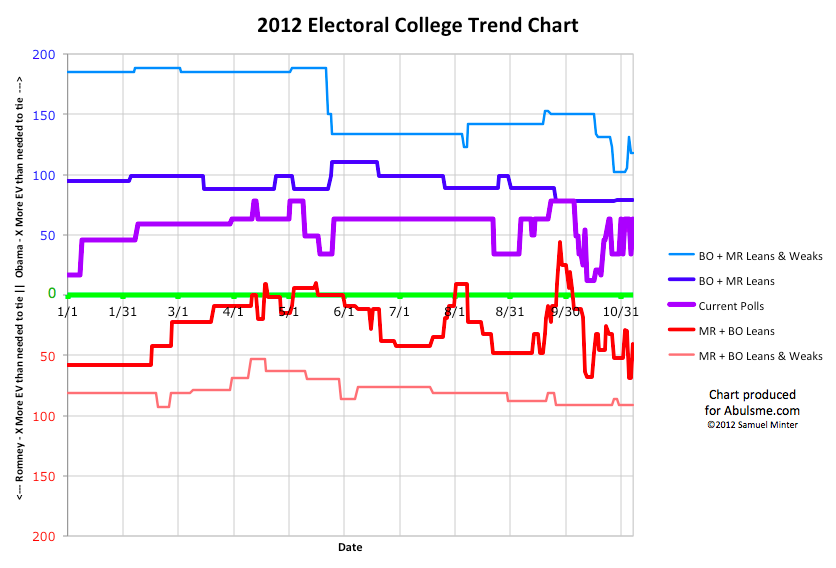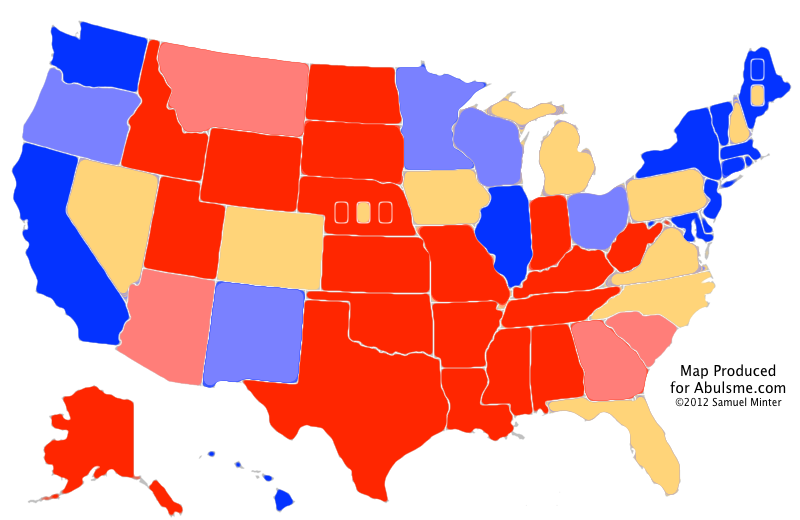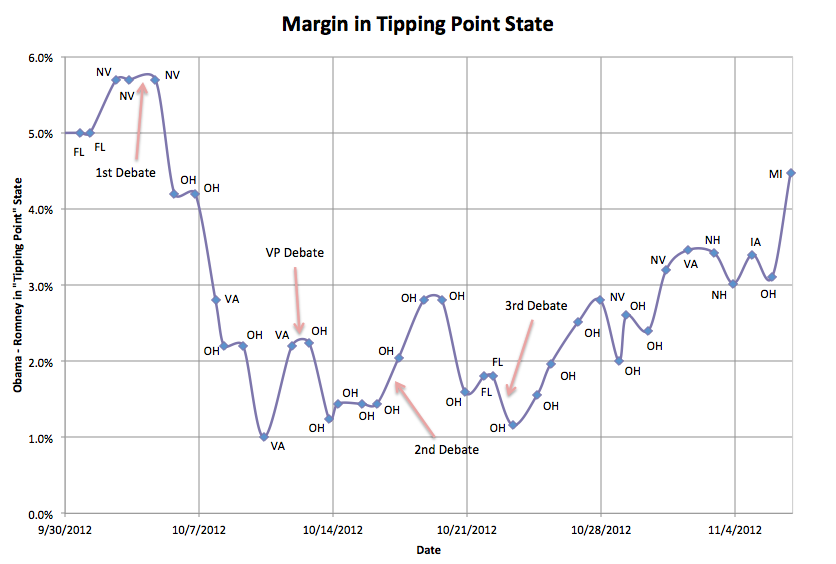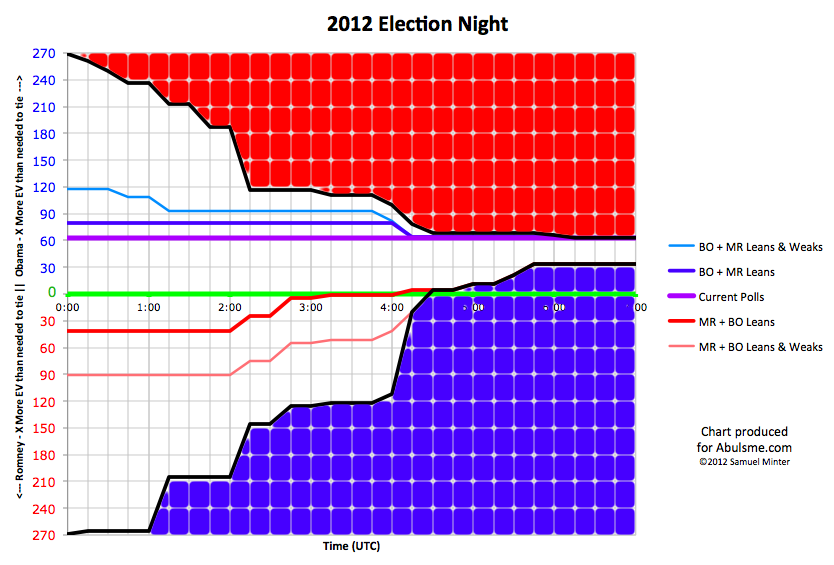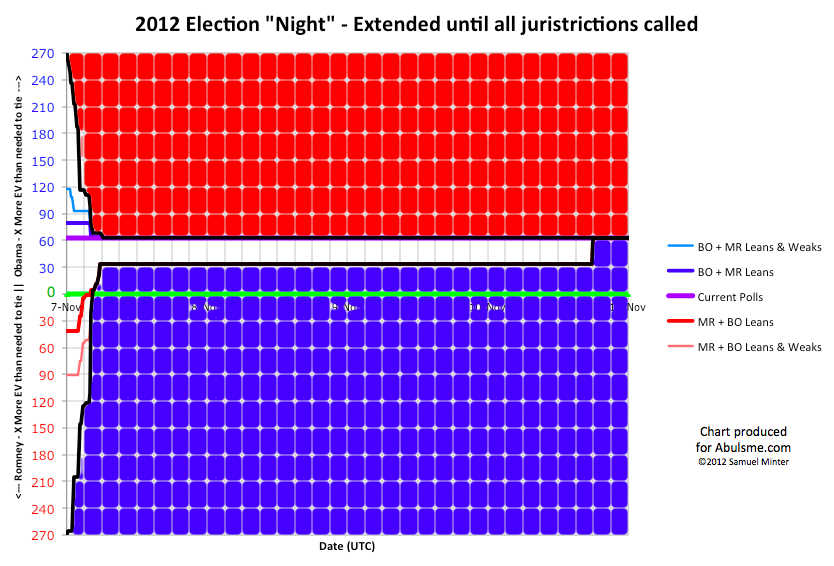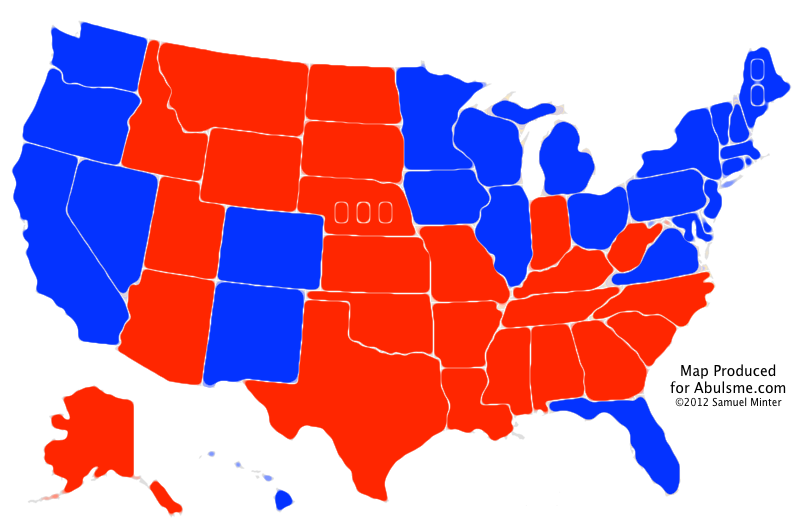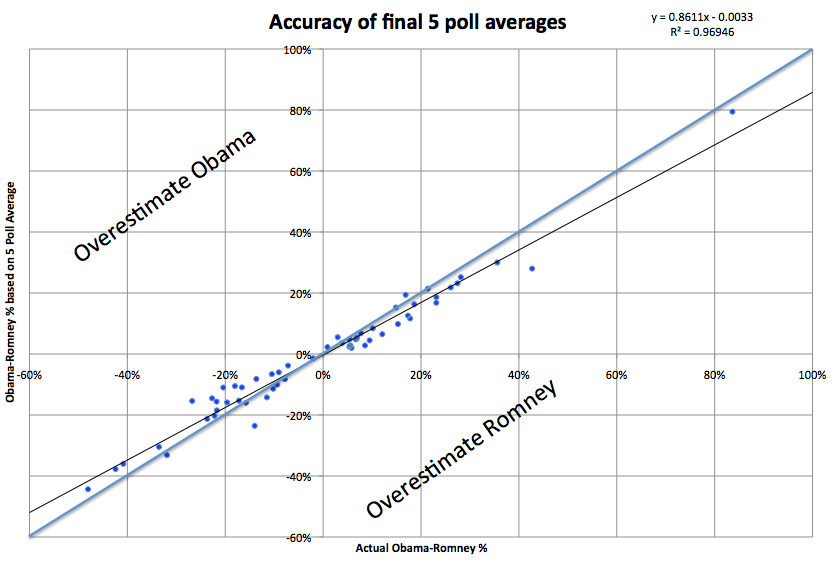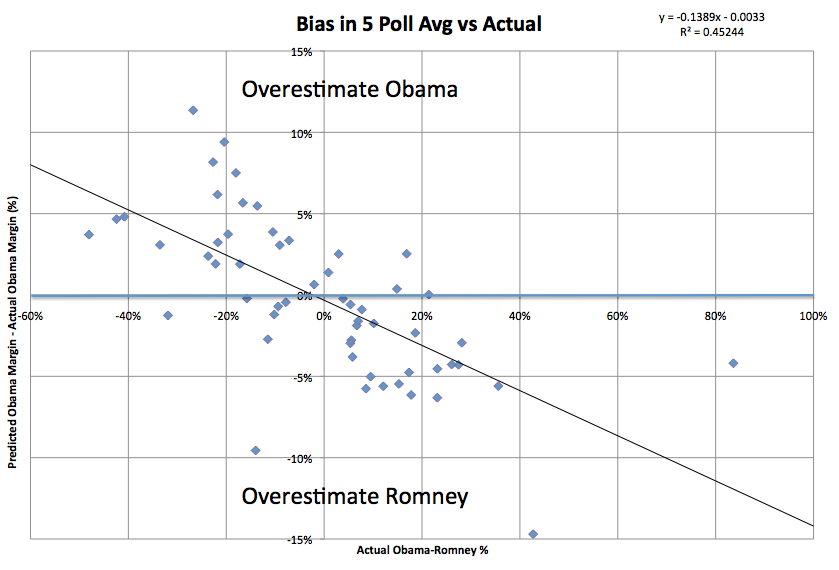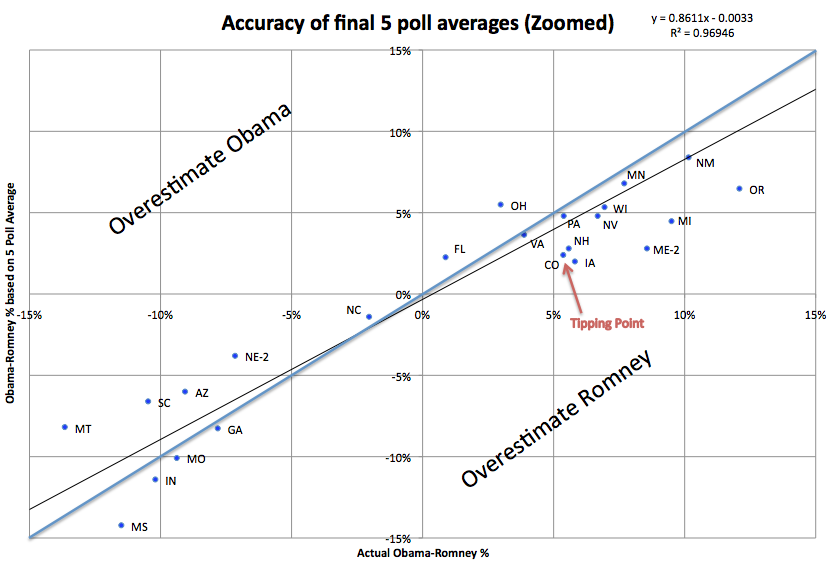2012 Electoral College Prediction
This is the archived version of the final state of the 2012 analysis. For 2016, see ElectionGraphs.com.
Welcome visitors. In addition to the 2012 election information here, please also check out one or more of the Abulsme.com blog, the Curmudgeon's Corner Podcast, the True Binary Time Clock, the Abulsme Random Spot Tool, the Mathematically Random Trips and the AbulCam. If you find any of this interesting, please do come back.
The following analysis assumes an Obama vs Romney general election, with no third parties strong enough to have the potential to win electoral votes.
Despite the title of this page, this represents the state of things NOW, as imperfectly determined by polling rather than a direct prediction for the November results. Essentially this shows the "if the election was held today" state of the race. Of course, until we get to election day, the election will NOT be held today. Between January and November, quite a lot happens, and the states ebb and flow between categories as events unfold. This is why these charts show changes over time rather than just the snapshot of “now”. The goal is to show how the situation changes over the 10 months (and a few days) of the 2012 campaign season.
Once we get into October and early November of course, the expectation is that the "if the election was held today" analysis starts to converge with actual expectations for November as the time for changes to happen diminishes.
For the archived historical version of this analysis for the 2008 election, please see the 2008 Electoral College Prediction page.
2012 Campaign
Electoral College Graph
August to November
Full Year
Map
All Lean states are colored gold regardless of who is slightly ahead, as these are really too close to call.
As has become convention, Blue states are Democratic, Red states are Republican.
The darker colors are "Strong" states while the lighter colors are "Weak" states.
Maine and Nebraska also show results for each congressional district, as those are also determinative of electoral votes.
Base map from Wikimedia Commons.
Tipping Point
The tipping point chart shows the margin in the "tipping point state". The tipping point state is the state that would contain the 269-269 point if the states were arranged in order by degree of support for the candidates. Another way to describe this margin is the amount you would have to move the polls in all states in order to flip the winner from one candidate to another. This differs from the popular vote margin due to the structure of the electoral college. In this chart, positive numbers indicate an Obama lead, whereas negative numbers indicate a Romney lead. Each daily data point is labeled by the state that was the tipping point state on that day.
Electoral College State Breakdown
| Romney Strong | Romney Weak | Romney Lean | Obama Lean | Obama Weak | Obama Strong |
|---|---|---|---|---|---|
|
Texas (38) |
Georgia (16) |
North Carolina (15) |
Florida (29) |
Ohio (18) |
California (55) |
| 151 | 39 | 16 | 104 | 50 | 178 |
| 190 | 120 | 228 | |||
| 206 | 332 | ||||
| 538 | |||||
Number of electoral votes for each state or congressional district (for Maine and Nebraska) in parenthesis. 269 electoral votes required to tie, 270 to win.
Potential Totals
| Romney | Obama | |
|---|---|---|
| Romney Best Case | 310 | 228 |
| Current Status | 206 | 332 |
| Obama Best Case | 190 | 348 |
The "Best Cases" assume that each candidate gets all of their strong and weak states, along with ALL of the leaning states, even those currently leaning to their opponent. The "Current Status" assumes each candidate gets their strong, weak and lean states. The winner in each scenario is highlighted in green. In a tie, both candidates are highlighted.
Commentary on Updates
- See Tag: 2012 Electoral College for all posts related to updates of these charts.
- See Tag: Election 2012 for more general commentary on the 2012 election cycle.
Election Night
All of the above represents the analysis during the campaign up through election day. The following represents the status of each state as the states are called by the major networks on election night. The time in the chart is UTC. Subtract 5 hours for Eastern Time, 8 house for Pacific time. Handily, 0 UTC is also the time the first full states close their polls, so this essentially also matches the number of hours after results start getting reported.
There were no faithless electors, so the results reported here matched the actual final results.
Prediction Chart
The area between the thicker red and blue lines represents the range of possibilities if Romney or Obama win the remainder of the close states that have not yet been called. The purple line represents the outcome if the remaining states all are won by the person ahead in the five poll average as of the last update on election day.
Updates are done every 15 minutes, so, for instance, states called between 00:00:00 and 00:14:59 were reflected in the graph as if they happened at 00:15:00.
The first chart shows the first 7 hours of election night proper, when 54 of 55 jurisdictions were "called". Each horizontal block is 15 minutes.
The second chart shows the first four days, to extend far enough to show Florida being called, shortly before 18:00 UTC on November 10th. Each horizontal block is three hours.
"Call" times were based on CNN, except for Florida, which was based on the alert from AP.
Map
Electoral College State Breakdown
| Romney Won | Romney Strong | Romney Weak | Romney Lean | Obama Lean | Obama Weak | Obama Strong | Obama Won |
|---|---|---|---|---|---|---|---|
|
Texas (38) |
California (55) | ||||||
| 206 | 0 | 0 | 0 | 0 | 0 | 0 | 332 |
| 206 | 0 | 332 | |||||
| 206 | 332 | ||||||
| 206 | 0 | 332 | |||||
Number of electoral votes for each state or congressional district (for Maine and Nebraska) in parenthesis. 269 electoral votes required to tie, 270 to win.
Potential Totals
| Romney | Obama | |
|---|---|---|
| Romney Best Case | 206 | 332 |
| Current Status | 206 | 332 |
| Obama Best Case | 206 | 332 |
The "Best Cases" assume that each candidate gets all of their remaining strong and weak states, along with ALL of the leaning states, even those currently leaning to their opponent. The "Current Status" assumes each candidate gets their strong, weak and lean states. The winner in each scenario is highlighted in green. In a tie, both candidates are highlighted.
Commentary on Updates
- See Tag: 2012 Electoral College for all posts related to updates of these charts.
- See Tag: Election 2012 for more general commentary on the 2012 election cycle.
Methodology
This chart presents the state of the race in a bit different way than many other visualizations, so some explanation is in order.
First of all, the current state of the race for each state (or congressional districts as well in the cases of Maine and Nebraska) is determined by looking at the average margin between the candidates in the last five polls in that area. In cases where five polls are not yet available, the final popular vote results in the 2004 and 2008 elections were used to "seed" the data.
States are then put into 3 categories.
- Lean: 0% ≤ Candidate Lead < 5% (States that are exact ties by the 5 poll average will be categorized by the 6 poll average instead)
- Weak: 5% ≤ Candidate Lead < 10%
- Strong: Candidate Lead ≥ 10%
All "lean" states are for all intents and purposes too close to call, but for the chart above, we separate them.
The chart is divided into two halves.
- Above the green line, the Democrat is winning with X more electoral votes than they need to tie. (So 269+X = their electoral vote total)
- Below the green line, the Republican is winning with X more electoral votes than they need to tie. (So 269+X = their electoral vote total)
We show five lines, outlining five different scenarios showing the range of possibilities given the current polling.
- Light Blue Line - The Democrat wins all states they are ahead in, but also flips the Republican's Lean and Weak states.
- Dark Blue Line - The Democrat wins all states they are ahead in, but also flips the Republican's Lean states.
- Purple Line - Each candidate wins the states they are ahead in, no states flip.
- Dark Red Line - The Republican wins all states they are ahead in, but also flips the Democrat's Lean states.
- Light Red Line - The Republican wins all states they are ahead in, but also flips the Democrats Lean and Weak states.
We assume that states where a candidate is "Strong" have essentially no chance of flipping.
The light lines would represent a very unlikely sweep with a candiate massively exceeding what polling would indicate in a large number of states at the same time.
But "Lean" states are essentially all too close to call, in that a 5% lead is small enough that it can easily be affected by natural random variations in polls, or even excluding those sorts of effects, a 5% move in opinion is easily possible in just a few days given particularly effective campaigning by one candidate, or a particularly bad gaffe by the other, or simply by the effects of the news cycle. So essentially anything between the dark blue and dark red lines should be considered to be quite possible given the current state of polling, although of course results closer to the purple line (representing the actual current state of polling) are more likely than results close to the dark red or dark blue lines.
Data and Sources
The spreadsheet used to generate these graphs is here. This includes specific URL sources for each poll included in this analysis.
The most frequently used sources are:
Accuracy Check
(The analysis below was also posted on Abulsme.com on 2013-07-14.)
While my analysis predicted 56 of 56 jurisdictions correctly (50 states, DC, ME & NE congressional districts), this is not the whole story. It is worthwhile to also look at the comparison between the final five point averages and the actual popular vote margins in each of these jurisdictions. Here is what you find:
There is no clear overall bias toward either Obama or Romney. The overall count gives 25 jurisdictions where my 5 poll average overestimated Obama's support, and 31 jurisdictions where my 5 poll average overestimated Romney's support. If anything, on an overall basis then, there is a slight bias in favor of Romney. But that isn't the real bias here.
Lets look at this again partitioning based on who won.
- Romney won 27 jurisdictions. Of those, 7 overestimated Romney's support, while 20 overestimated Obama's support.
- Obama won 29 jurisdictions. Of those, 5 overestimated Obama's support, while 24 overestimated Romney's support.
So the overwhelming pattern here is that although there are clearly exceptions, in general, the polls overrepresented the support level of the person who lost the state.
In other words, the polls are not biased toward either candidate. The polls are biased toward showing a CLOSER RACE than the actual results.
The trend can been seen even more clearly if you subtract out the actual results, leaving only the deviation or bias:
If the polls were very generally right, you would expect a horizontal line very close to zero.
If there was a direct bias for one candidate or another you would expect a horizontal line, above zero for an Obama bias, below zero for a Romney bias.
We see positive to the left and negative to the right though, meaning the bias is generally toward the underdog, whoever that is. (In other words, again, a bias toward a closer race.)
More than that though, the less close the race is, the greater that bias is. It isn't just that races that are less close are polled less often and so are generally further from the right answer, but rather the bias toward making it closer increases too.
In Hawaii, where it was clear Obama was going to win by very high margins, the polls overestimated Romney by 14.7%! (Polls said Obama would win by 28%, Obama actually won by 43%.)
Similarly, in West Virginia, where it was clear Romney was going to win by very high margins, the polls overestimated Obama by 11.4%! (Polls said Romney would win by 15%, Romney actually won by 27%.)
Those were the two worst states in terms of accuracy of the five poll average. Rounding out the worst five are Alaska (R+9.6%, a big exception to the trend... where there were no polls at all and the 5 poll average was based on the 2004 and 2008 elections), Tennessee (O+9.4%), Kentucky (O+8.2%).
The best five were: Maine-1 (O+0.03%), Texas (R+0.2%), Virginia (R+0.2%), Washington (O+0.4%), Georgia (R+0.4%).
Now, in the end, the degree to which each candidate wins (especially in the states they are way ahead in) doesn't really matter. We have a winner take all system, so this bias actually makes a lot of sense in terms of how pollsters work. Having the margin wrong doesn't matter much in these kinds of races, only the winner matters (and the poll averages were all correct on that front). Also of course, close races are more interesting, and people are more likely to commission polls if it looks closer... so the biases all make sense.
But lets take a closer look at the states that were even remotely in contention, where the margins were under 15%. That actually includes a lot of places I wouldn't really consider "close" but it gives a good number to look at:
Now, I had categorized using "Strong Romney", "Weak Romney", "Lean Romney", "Lean Obama", "Weak Obama", "Strong Obama". Lets look at how things stacked up in terms those categorizations... specifically the "lean" states.
You can see from the chart above, that even among the states near the "tipping point" where you would think polling would be most robust, the error is significant. The tipping point is of course on Obama's side, since he won. But what we see is that of states that the last five poll average identified as "Lean Obama"... that is, Obama ahead, but with a margin under 5%... so close enough you could conceivably think Romney might take it... only TWO actually ended up with margins under 5%. That would be Florida and Virginia.
On the other hand, the five poll average identified each of these states (and one congressional district) as "close", but in fact it was pretty much an Obama blow out:
| 5 Poll O-R | Actual O-R | Bias | |
|---|---|---|---|
| Colorado | 2.4% | 5.5% | R+3.0% |
| Pennsylvania | 4.8% | 5.4% | R+0.6% |
| New Hampshire | 2.8% | 5.6% | R+2.8% |
| Iowa | 2.0% | 5.8% | R+3.8% |
| Nevada | 4.8% | 6.7% | R+1.9% |
| Maine-2 | 2.8% | 8.6% | R+5.8% |
| Michigan | 4.5% | 9.5% | R+5.0% |
There was only one state with the opposite pattern... that is, the five poll average indicated Obama with a healthy safe lead of more than 5%, and the actual results were a win by less than 5%. That would be Ohio. The 5 Poll average had Obama ahead by 5.5%. In actuality he won by only 3.0%
On the Romney side, there were less close places to look at. There were no cases where the five poll average classified something with Romney having a greater than 5% where it ended up being closer than that. There was ONE case where the five poll average showed a close race where it really wasn't. That would be Nebraska-2, where the five poll average showed only a 3.8% lead. In fact, Romney won Nebraska-2 by 7.2%.
The lesson in all this for 2016? Probably just that "Lead under 5%" isn't enough to actually think that a state has a real possibility of going either way, that it is really up for grabs. Especially if the form of bias evident here (bias toward the races looking closer than they really are) repeats next time around, which I think is a reasonable assumption.
Some tighter criteria is needed. Maybe just a narrower percentage lead, but maybe also something else. Perhaps an actual history of the lead bouncing back and forth, or the actual current set of polls including results going both way.
Of the five closest states based on actual results (Florida, North Carolina, Ohio, Virginia, Colorado) only Florida had even one of the last five polls indicating the opposite winner (although North Carolina and Colorado had last minute polls showing a tie). Of course five results showing a lead of 0.1% should probably be considered differently than 5 results showing a lead of 4.9%.
The more mathematically proper thing would probably be to take into account the margins of errors on each poll, and come up with an actual probability of the result being on the opposite side than the simple five poll average. There is a place for more complicated models (and I love them!) but part of the point of my analysis is that you can come up with results that are essentially just as good through very simple models with no fancy stuff, just simple averages.
If we went by a rule saying we would only consider a state to be a true toss up if at least one of the last five polls showed a different result, then on election eve 2012, the only Toss-Up state would have been Florida.
I have yet to decide what I will do in 2016, but considering Florida to be the only true toss-up seems closer to the truth than the analysis that put the seven entities in the table above (and NE-2) in the toss-up category.
